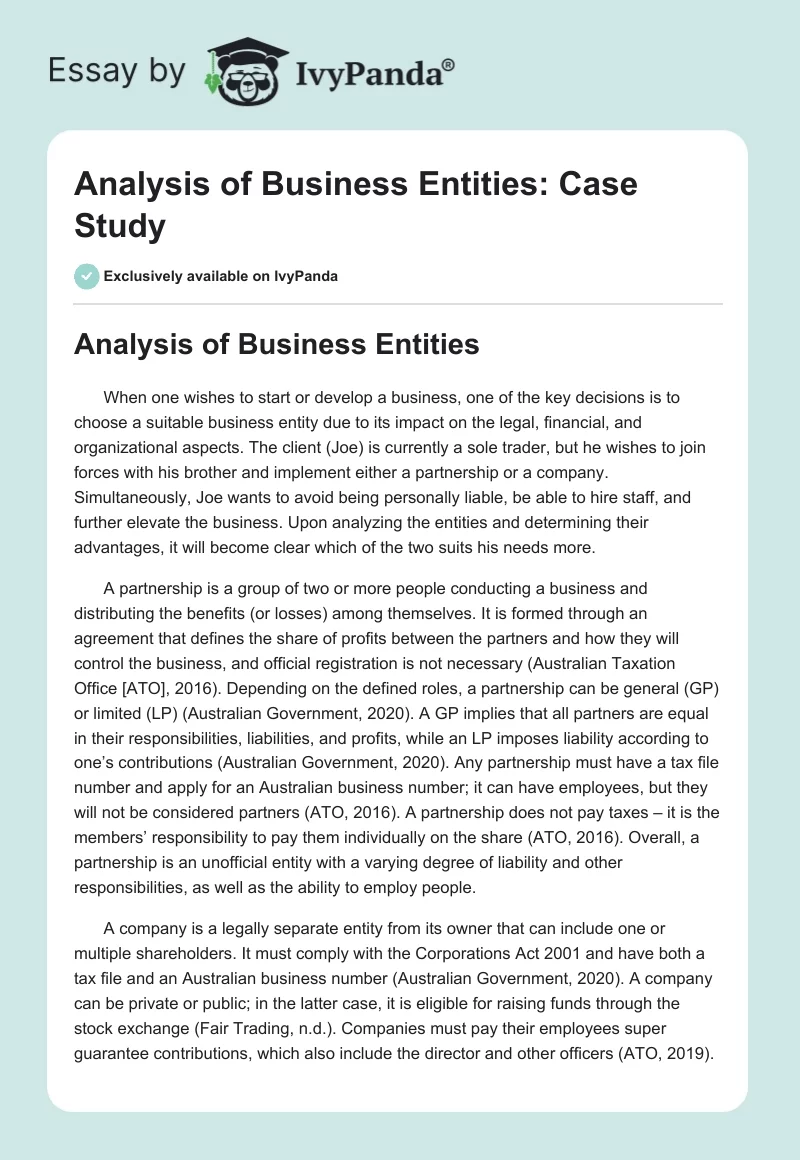Analysis of Business Entities
When one wishes to start or develop a business, one of the key decisions is to choose a suitable business entity due to its impact on the legal, financial, and organizational aspects. The client (Joe) is currently a sole trader, but he wishes to join forces with his brother and implement either a partnership or a company. Simultaneously, Joe wants to avoid being personally liable, be able to hire staff, and further elevate the business. Upon analyzing the entities and determining their advantages, it will become clear which of the two suits his needs more.
A partnership is a group of two or more people conducting a business and distributing the benefits (or losses) among themselves. It is formed through an agreement that defines the share of profits between the partners and how they will control the business, and official registration is not necessary (Australian Taxation Office [ATO], 2016). Depending on the defined roles, a partnership can be general (GP) or limited (LP) (Australian Government, 2020). A GP implies that all partners are equal in their responsibilities, liabilities, and profits, while an LP imposes liability according to one’s contributions (Australian Government, 2020). Any partnership must have a tax file number and apply for an Australian business number; it can have employees, but they will not be considered partners (ATO, 2016). A partnership does not pay taxes – it is the members’ responsibility to pay them individually on the share (ATO, 2016). Overall, a partnership is an unofficial entity with a varying degree of liability and other responsibilities, as well as the ability to employ people.
A company is a legally separate entity from its owner that can include one or multiple shareholders. It must comply with the Corporations Act 2001 and have both a tax file and an Australian business number (Australian Government, 2020). A company can be private or public; in the latter case, it is eligible for raising funds through the stock exchange (Fair Trading, n.d.). Companies must pay their employees super guarantee contributions, which also include the director and other officers (ATO, 2019). The business’s money belongs to the company, so it is impossible to withdraw; an annual tax return and a review are also required (Australian Government, 2020). Overall, a company is characterized by being a separate being from its owner, which removes liability from the latter but forces the owner/director to comply with many regulations.
Both entities have strong points and significant drawbacks, determining whether a person will proceed with either of them. A partnership’s advantages include the relative ease and low cost of establishing it, shared responsibilities, and relaxed reporting duties. The drawbacks are unlimited liability, making a person pay with their private property for debts, individual taxation, and potential disputes if the agreement is not clearly defined (Queensland Government, 2016). A company’s main strength is its legal separation from the owner, and the minor advantages may include wider capital access and a steady formation, meaning that changes in ownership will not affect it, unlike a partnership. The disadvantages include the difficulty of establishing and running one, considering the expenses and the necessity to register it, increased reporting responsibilities, and compliance with various regulations, which puts additional strain on the budget (Australian Government, 2020). Overall, both entities have their strengths and drawbacks, some of which can dissuade a person from implementing it, and the summary is presented in Table 1.
Table 1. The entities’ advantages and disadvantages.
Key Findings and Recommendations
The analysis has demonstrated that both entities have certain challenges that might make a person reconsider choosing them to advance their business. For instance, while a partnership is easy to establish, it comes with unlimited liability and the inability to remove other partners in emergency cases. On the other hand, a company is an expensive venture, but its director might not have to worry about financial and legal repercussions. Based on the client’s needs, the suitable choice might be the latter, as he wishes to protect personal assets and grow the business, for which a company seems more flexible. Both entities enable employment, although a partnership is more lenient with employee benefits, which is not necessarily a retaining factor. As far as control is concerned, a partnership is equal, but it depends on the brothers’ role in the company. Ultimately, the biggest barrier to establishing a company is the cost, but the investment might be profitable in the long run, considering other advantages and factors, the latter summarized in Table 2.
Table 2. Factors determining the chosen recommendation.
Conclusion
As evident from the findings, choosing a business entity is a challenging task, as many factors should be considered, which was conducted for a partnership and a company. Either can accommodate its owners but offer different packages and justifications for operating in a certain way. The ultimate recommendation was to pursue the latter because it suits the client’s needs more, and it might be consistent with what he seeks in expansion opportunities.
References
Australian Government. (2020). Common business structures. Web.
Australian Taxation Office. (2016). Partnership. Web.
Australian Taxation Office. (2019). Company. Web.
Fair Trading. (n.d.). Business structures. Web.
Queensland Government. (2016). Partnership business structure. Web.


